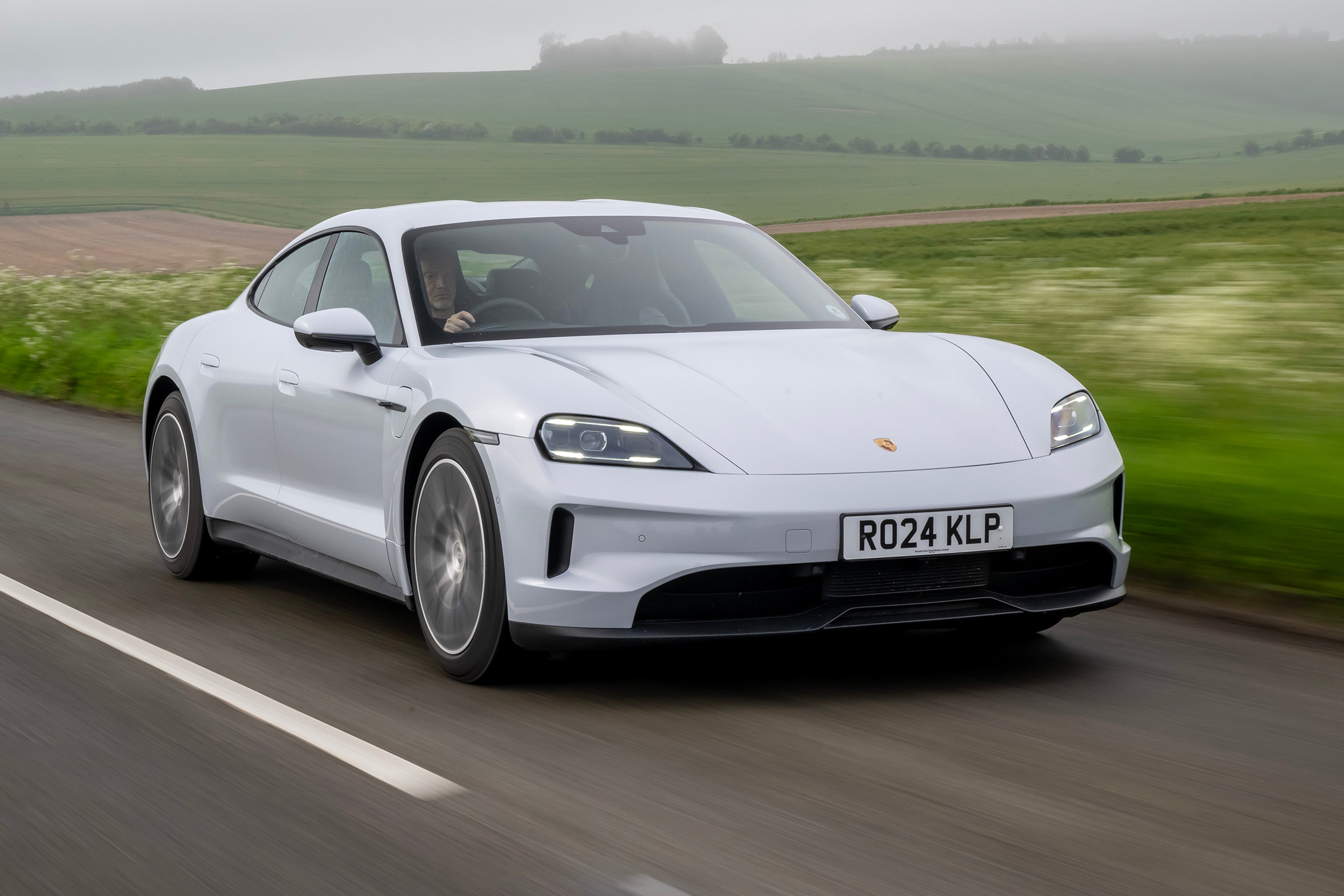Porsche Taycan Review 2025: Price, specs & boot space
Written by Matt Robinson
- 2019
- Performance
- EV
Quick overview
Pros
- Fast and fun to drive
- Very well built
- Range figures improved for the facelift version
Cons
- Small infotainment screen by modern standards
- Dizzying array of expensive options to add to a high starting price
- Fastest models seem a bit pointless
Overall verdict on the Porsche Taycan
"The Porsche Taycan has some much tougher competition to contend with since it launched back in 2019, but a recent update and an uplift in standard equipment make it more appealing than ever. Plus, it remains one of the most fun-to-drive EVs out there."

We knew Porsche wasn't going to do things by half when releasing its first production electric car. Sure enough, the Taycan came along and set a benchmark for how enjoyable an EV can be to drive beyond simply being quick in a straight line.
They can do that too, of course. In fact, the Taycan Turbo GT released in 2024 is Porsche's fastest accelerating car ever, and by quite some margin over its briskest petrol-engined vehicles. All the while, the Taycan is very well made, looks fantastic (if not quite as striking as 2015's Mission E concept), and can go reasonably far on a full charge.
The extremely fast pace of the EV world means that the Taycan isn't looking as strong as it once was, but a raft of updates in 2024 have helped the Porsche stay mostly on terms with its rivals including the BMW i5, Mercedes-Benz EQS and the Audi e-tron, which shares quite a bit with the Taycan under the skin.
More recently, an uplift in standard equipment has made Porsche look far less stingy with what it expects you to pay extra for. That said, there are still myriad ways to vastly inflate the price of what is already an expensive car, so you'd do well not to get too carried away on the configurator. Not that this will matter to a lot of Taycan drivers, who'll take advantage of current company car tax rules to drive away in one of these premium EVs for a tiny monthly payment.
The range is vast, with the range-topping model costing more than double the entry-level version and producing two and a half times the power. With that in mind, there's something for everyone in the range, but we have a soft spot for the cheapest version.
Looking for a used car for sale? We've got 100s of Porsche Approved Used Cars for Sale for you to choose from.
Is the Porsche Taycan right for you?
If you want a luxury EV that'll take you far on a charge and also be enjoyable to drive, it's hard to do better than the Porsche Taycan. Yes, the Audi e-tron GT is made from a similar box of bits, but it just doesn't put a smile on your face quite in the same way as the Taycan. That’s assuming, of course, you can afford it, this is a Porsche after all, so it’s not cheap.
We’d be amazed if any Porsche Taycan buyer hasn’t at least another Porsche in the garage – and likely several. Likewise, we doubt Tesla owners will be buying the Taycan in big numbers, either, such is the brand loyalty towards their chosen EV. Ignoring the huge price, if that’s possible, the Taycan could be for everyone, it being among the first EVs that feels like a car first, and an EV second, and that’s what makes it so significant.
What’s the best Porsche Taycan model/battery to choose?
There's something to be said for sticking to the base model Taycan with the larger Performance Battery Plus (made standard across the range part-way through 2025) if you think you'll make use of the additional range. It still feels extremely quick, and although we've not driven the new range-topping Turbo GT yet, our experience with the pre-update version of the Turbo S suggests it'll feel almost unpleasantly quick, and the novelty of its extreme performance will likely wear off.
You'll certainly save a lot of money by ignoring the faster models - with the Weissach Package added, the Turbo GT is more than two times the price of the entry-level Taycan. Sure, it's two and a half times as powerful, but really, you don't need all that performance. The most you might want to do is upgrade to the 4S, which isn't drastically more expensive than the base Taycan but a decent amount quicker and more capable owing to its all-wheel drive system.
What other cars are similar to the Porsche Taycan?
The choice of electric cars used to be sparse, and in the Taycan’s performance sphere, limited to one – that Tesla Model S. That's changed dramatically in the years since the car's release. For one thing, it has a rival in the form of the Audi e-tron GT, which is made from a lot of the same components, and while it isn't quite as good to drive, we reckon it has the edge in terms of looks.
The Mercedes-Benz EQE and EQS could both be considered strong alternatives, although the styling of each is a bit anonymous. If you're opting for a used Taycan and don't mind an SUV instead of a saloon, the Jaguar I-Pace might be worth a look. It's no good as a new/nearly new purchase, though, as it's been discontinued, along with the entire Jaguar range, as the brand reinvents itself for a more luxurious buyer.
In some countries, the Lucid Air is a Taycan rival, but it's not on sale in the UK. Finally, although it doesn't have an answer for the higher-end versions of the Taycan, the BMW i5 range crosses over with that of the Porsche.
Comfort and design: Porsche Taycan interior
"The cabin design pulls off the neat trick of not just being familiarly Porsche in its layout and design, but achieves that while resolutely bringing the future to the interior. "
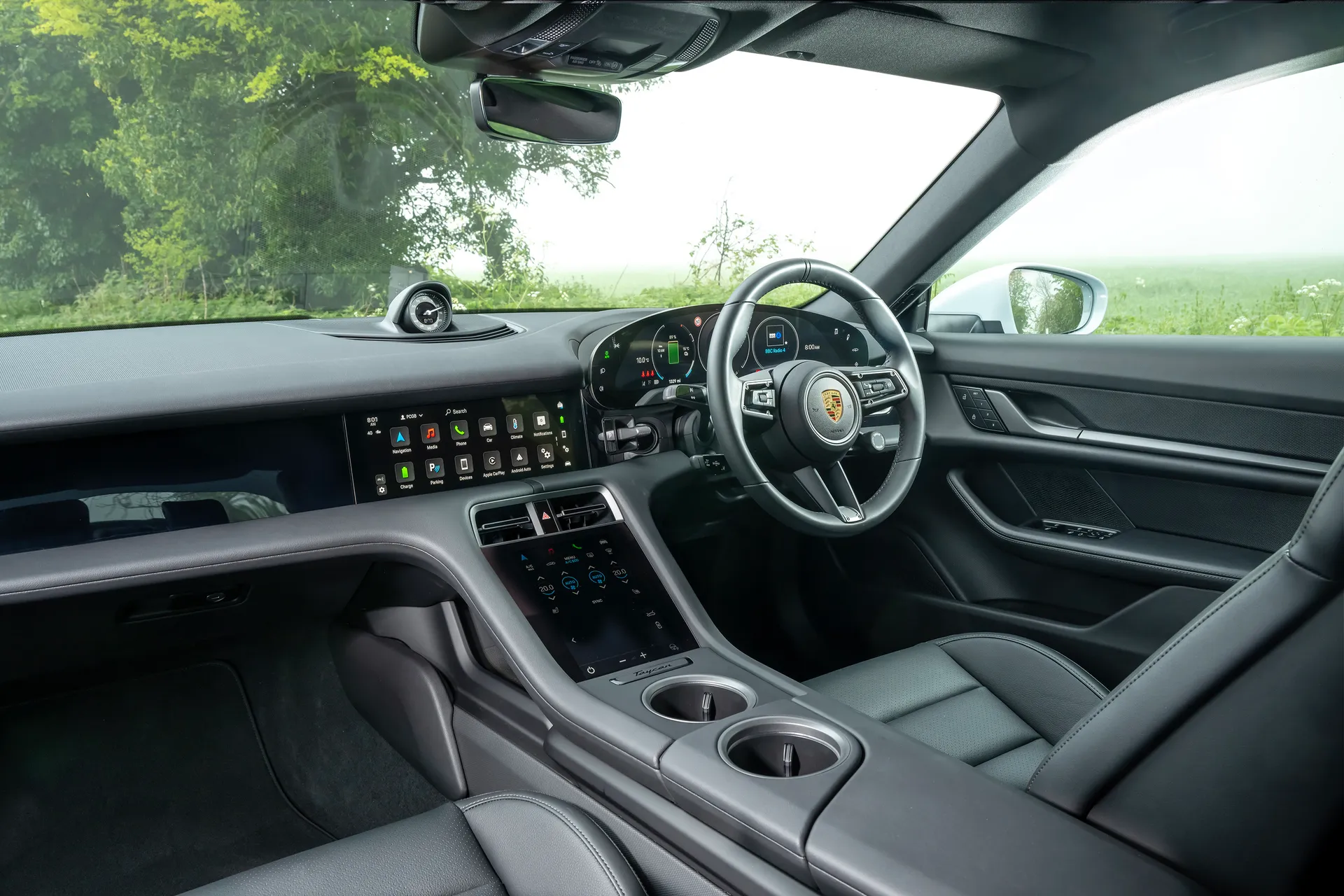
Porsche made a lot of noise about it being the sportiest car to sit in alongside the 911 when the Taycan was launched, and while that might sound like marketing-led drivel, it actually transpires to be true in reality. You sit low, in excellent 8-way electrically adjustable comfort seats as standard on the 4S (14-way electrically adjustable in the Turbo) or, the Adaptive Sports Seats in the Turbo S, which feature a memory function to set up your favoured driving position.
There’s plenty of options you’ll need to tick for the ultimate in comfort, with seat heating and ventilation optional, massaging seats available too. Likewise, you can pay to have the steering wheel heated. The ventilation is good, but using it needs a bit of practice, Porsche, in an unusual own-goal, putting the controls for the ventilation within a lower touchscreen, which makes it fiddly and awkward to set up, particularly on the move.
It feels inside, very much like a driver’s car, from that low position, to the cockpit feel created by that high centre console which contains one of the many touchscreens to feature in the Taycan’s cabin. The instruments are replaced by a screen, but Porsche has cleverly adopted the shape of the instrument cowl of its conventionally powered cars, to retain that family look, it said to be inspired by the 993-generation 911.
That it all manages to feel and look familiar, but sophisticated, classy and futuristic at the same time is a very impressive design trick, and makes it feel like it’s worth the not insignificant sum you need to pay for the privilege of sitting in the driver’s seat.
Quality and finish
The interior of the Porsche Taycan doesn’t just look sensational, but it feels it, too. Indeed, in this respect it’s right at the top of its class, bettering even Audi’s e-tron here, and making the Tesla Model S feel downright shoddy in places in comparison.
That solidity and fine material choice is apparent everywhere, with all the surfaces you touch feeling substantial but tactile at the same time, Porsche not scrimping on materials that are out of sight, either. In short, the Taycan, in any specification feels very special inside, but at the price Porsche asks for it, then it really should.
The only real fly in the ointment is the over-use of 'piano black' plastic trim. It looks nice and shiny to begin with, but has a habit of picking up scratches over time. Our test car has done around 11,000 miles, and the trim piece on the passenger side of the car was looking particularly scratched up whenever the light caught it.
Infotainment: Touchscreen, USB, nav and stereo in the Porsche Taycan
There are more screens in the Taycan than NASA’s mission control room, with the instrument panel, top centre dash and lower dash all having screens. Those on the centre console are haptic touchscreens and might be familiar to you if you’re already a Panamera or 911 owner, the Taycan borrowing, but building on the infotainment from its relations.
The digital instruments are particularly neat, being configurable, offering a choice of displays covering anything from dials aping that of which will be familiar to any Porsche driver, to mapping and the EV drivetrain status.
If the standard three screen set-up isn’t quite enough screens for you, there’s the option of an additional 10.9-inch touchscreen in front of the passenger, in case your passenger is incapable of stretching to touch that central one – it’s a little bit superfluous, and the £1,060 extra it costs, ridiculous.
The operation of those screens is relatively simple, though we do concede that Porsche’s obsession with removing buttons and switches isn’t entirely successful, changing things like ventilation and temperature being needlessly fiddly. For the actual infotainment itself though it’s agreeable enough, and relatively easy.
The screen looks a little small by modern standards, and some of the icons and information displayed on it end up also being a bit diddly and thus tricky to use on the move. It's a decent setup overall, though, and finally, Porsche is offering Android Auto with these systems alongside Apple CarPlay, having for years only fitted the former.
Although there is a 14-speaker Bose sound system available (optional in some versions, standard in others), the standard, unbranded eight-speaker setup will do the job for most. At the other end of the scale is a 21-speaker Burmester 3D sound system, if you can stomach the enormous cost of speccing it.
Space and practicality: Porsche Taycan boot space
The Taycan might adopt a cockpit-like, low down driving position like its sports car relations in the Porsche line-up but it also shares another of their facets.
There are two luggage compartments, one in the front, and another conventional one in the rear. That front (frunk if you like) boot, offers 81-litres of luggage space, which is enough for a decent-sized squashy bag, though it is more likely to be used to store charging cables etc, leaving the rear boot free, and cleaner, for luggage.
There’s 407 litres of space in the rear boot of the RWD and 4S Taycan models, with the Turbo and Turbo S losing a bit of boot space with a 366-litre compartment. The back seats do fold down in a 60/40 split if you need more space, or for longer loads, and don’t need the space for passengers. It’s practical enough then, if not as spacious as that Model S from Tesla.
The Porsche Taycan has dimensions of 4963mm long and 1966mm wide, so it's a big car. That said, you’re snug in the front. However, that's not due to a lack of space, just that connection with the car. It's also pretty snug in the rear, but that's more to do with less space back there.
Porsche has gone as far as mining some recesses out of the battery to provide foot space for rear-seat passengers, but if you’re taller than five-foot 10 you’ll find it pretty cramped back there. It’s absolutely fine for children, though, and there are ISOFIX mounts on the outer rear seats too. As standard, there’s seating for four, with Porsche offering an optional 2+1 rear seat package, which squeezes another seat belt between the rear seats.
It’s tight back there if you do pick that, but it does add the advantageous 40/20/40 rear seat back split if you want to drop the middle and sling skis or suchlike through the cabin. There are a pair of large cup holders, a lidded cubby in the centre console, a good-sized glove box and door bins in all four doors, making the Taycan a genuine day-to-day proposition.
Handling and ride quality: What is the Porsche Taycan like to drive?
"It's a heavy car, but most of the time, the Taycan simply doesn't feel it. It's as happy being thrown around as most Porsche models are while feeling very involving and - yes - extremely fast."
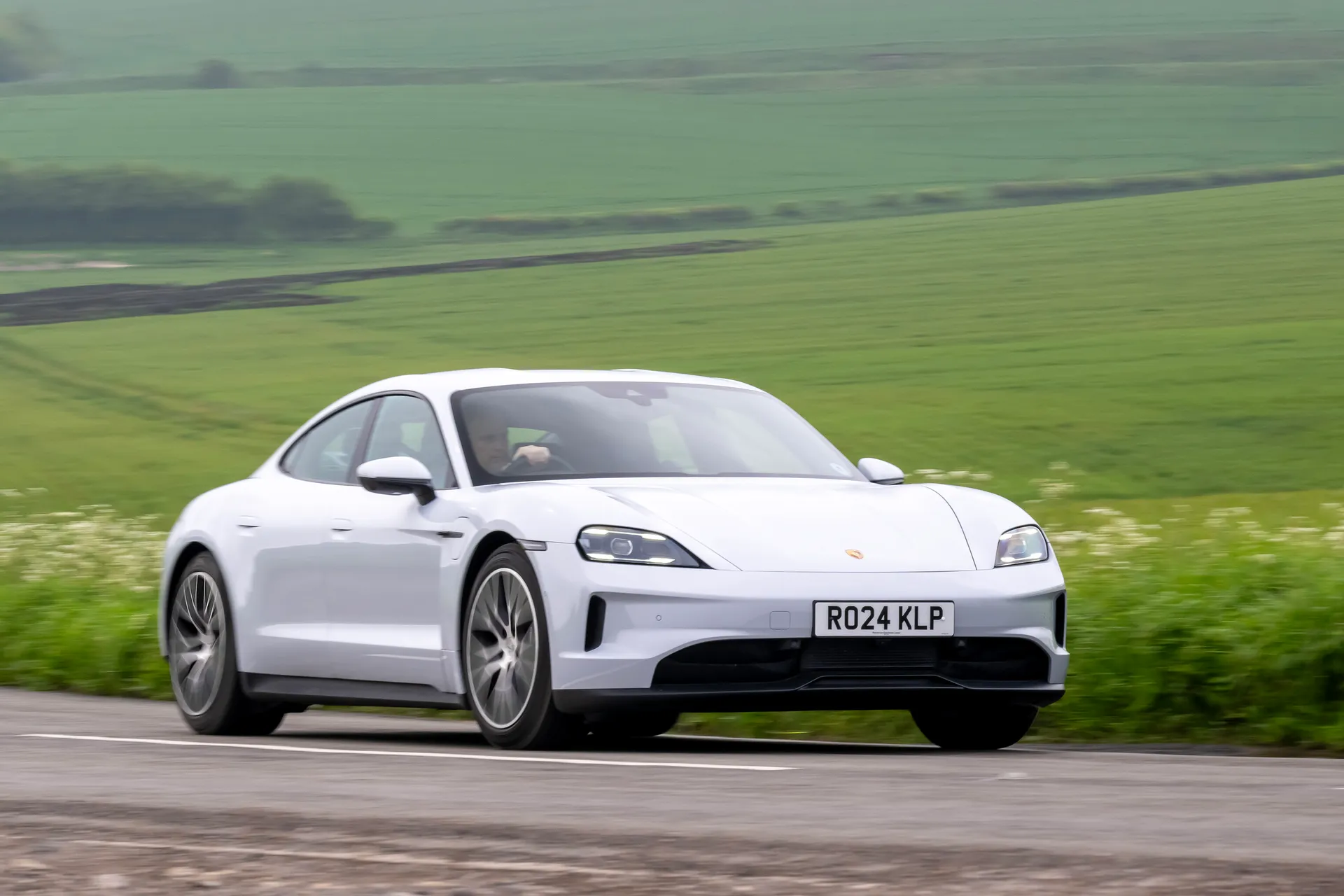
The best-driving Taycan is probably the cheapest. That's because it only has a single motor which sits at the rear axle, making it the only version which is rear-wheel drive. That makes for at times lively handling, even with the electronics fully on (not that we can recommend partially or fully disengaging them on the road, of course).
That's not to say it's scary to drive. It always feels like it has your back, and just requires the driver to pay a little more attention than in other versions of the Taycan, and be a little more careful about applying the throttle.
Although the base Taycan does feel a little pointier than the all-wheel drive models, they're all agile cars that shrug off their 2.2-tonne weight figures. We see this often with EVs, which typically mount their batteries very low in the car, lowering the centre of gravity, meaning you don't feel that weight as much when in corners.
This is especially true of the Taycan, but with the added benefit of what Porsche calls 'foot garages' - gaps in the battery pack for your legs to sit in, enabling a low-slung, sports-car-like seating position. This is fitting given that the Porsche genuinely feels like a sports car to drive, and more like one than the only actual electric sports car currently on sale - the MG Cyberster. The steering helps - only a handful of supercar manufacturers can make as natural-feeling steering as Porsche can.
What we especially like is the ride/handling balance. Body roll is all but absent, and yet, the suspension effortlessly soaks up all but the worst imperfections in the road surface. Making that more impressive still is that our test vehicle didn't have Porsche's trick adaptive dampers fitted .
The all-wheel drive models don't feel quite as nimble, but really, there's precious little in it, especially where the clever rear-wheel steering system is fitted. The flipside is more traction, especially in the wet, and a lot more performance. In some cases a bit too much. The pre-facelift Turbo S was already ridiculous enough with its 750PS output, but that car now puts out 952PS.
In updated form, we've also tried the Taycan Turbo, which is now good for 884PS during its overboost mode. A launch control start, which allows for a 2.7-second 0-62mph time, was actually a bit painful, and borderline unpleasant. The Turbo S and the GT, then, seem especially needless. At the other end of the scale, the base Taycan hardly feels slow and surprised us the first few times the throttle was fully applied.
What motors and batteries are available in the Porsche Taycan?
The size of your Taycan's battery will depend on what version it is, if it's pre or post-facelift, and if it was made after a certain point in 2025. Which isn't quite as confusing as it sounds.
Initially, the Taycan had a 79kWh battery as standard, with a 93kWh Performance Battery Plus available as an option on models lower down the pecking order and as standard on the fancier derivatives. For the 2024 facelift, the standard battery grew to 93kWh, and the Performance battery 105kWh. Part-way through 2025 Porsche rolled out the 105kWh Performance Battery Plus across the range and ditched the smaller battery entirely.
The facelift brought about power and performance increases across the board, too, some of them quite dramatic. Porsche quotes two power figures for each model, but to avoid throwing to many numbers at you, we'll quote the higher one for each, which is available for short bursts via what it calls 'overboost'. All of the 0-62mph times, meanwhile, apply only if launch control is engaged.
For the single-motor Taycan, this is 430PS, providing a 0-62mph time of 4.8 seconds. All other models feature two motors - one for each axle to provide all-wheel drive. The cheapest of these is the 4S, which procudes 598PS and can charge from 0-62mph in 3.7 seconds. In the GTS it's 700PS and 0-62mph in 3.3 seconds, while the jump to the Taycan Turbo is where things get really quick, with 884PS and a 0-62mph time of 2.7 seconds. That's excessive if you ask us, but if you for some reason want more, there's the 952PS Turbo S with a 0-62mph time of 2.4 seconds, or the Turbo GT with 1,034PS and a 0-62mph of 2.3 seconds.
Finally, there's the Turbo GT with Weissach Package, which doesn't produce any more power but can dispatch 0-62mph in 2.2 seconds thanks to its reduction in weight and stickier tyres.
Maximum EV range in the Porsche Taycan: how far can you travel on a full charge?
The entry-level Taycan can go the furthest on a charge at 421 miles, and then it's 400 miles for the 4S, 398 for the GTS, 391 for the Turbo, 393 for the Turbo S, 344 for the Turbo GT, and 345 miles for the Turbo GT with Weissach.
These mark a dramatic improvement from the pre-facelift version, for which 300 miles for the entry-level car with the larger battery was as good as it got, while some weren't much over 250 miles.
Official range figures are notoriously difficult to replicate in normal driving conditions, but the 3.6 miles per kWh we achieved with a base Taycan at a colder time of year and driving a lot of motorway miles (neither is good for EV efficiency), suggests you should be able to get well over 300 miles of driving before being able to stop and charge.
Refinement and noise levels
The lack of pistons hammering away in a big metal block while spewing out hot gasses and sucking in air to feed it makes electric vehicles incredibly quiet compared to normal cars. Indeed, it’s unnerving at first, especially if you pin the accelerator to the floor, the resulting catapult performance not being accompanied by a cacophony of sounds.
There are the faintest electrical notes, and, if you’ve optioned Porsche’s Electric Sport Sound Generator, a synthesised approximation of a performance sound, that’s unusual but not unpleasant, and switchable if you want the serenity of silence.
Wind and tyre noise become a real headache for EV engineers, as there’s nothing else to mask them with, but, impressively, the Taycan manages to keep both under control – at least at regular speeds and on finer surfaced roads. At town speeds the Taycan is a paragon of refinement, which is a sizeable part of its appeal.
Safety equipment: How safe is the Porsche Taycan?
Besides the Taycan’s incredible agility being useful in helping you avoid an accident in the first place, Porsche has loaded it with a sizeable standard safety equipment list. There are full-sized driver and passenger front and knee airbags, front side airbags, curtain airbags with roll-over detection, ABS, traction and stability control, tyre pressure monitoring, multi-collision braking and hill hold assist with all models.
There’s a pop-up bonnet for pedestrian protection too. Standard assistance systems include Lane Keeping Assist with traffic sign recognition, Collision and Brake Assist and Park Assist. All that meant that in Euro NCAP crash tests, the Taycan was awarded a five-star maximum rating.
Additionally, there’s the option of Adaptive Cruise Control, Night View Assist, Porsche Innodrive with Active Lane Keeping, Emergency Steer Assist and Intersection Assist.
Charging times: How much does it cost to charge the Porsche Taycan?
"With its 800V electronics, the Taycan can be charged from 10-80% in as little as 18 minutes."
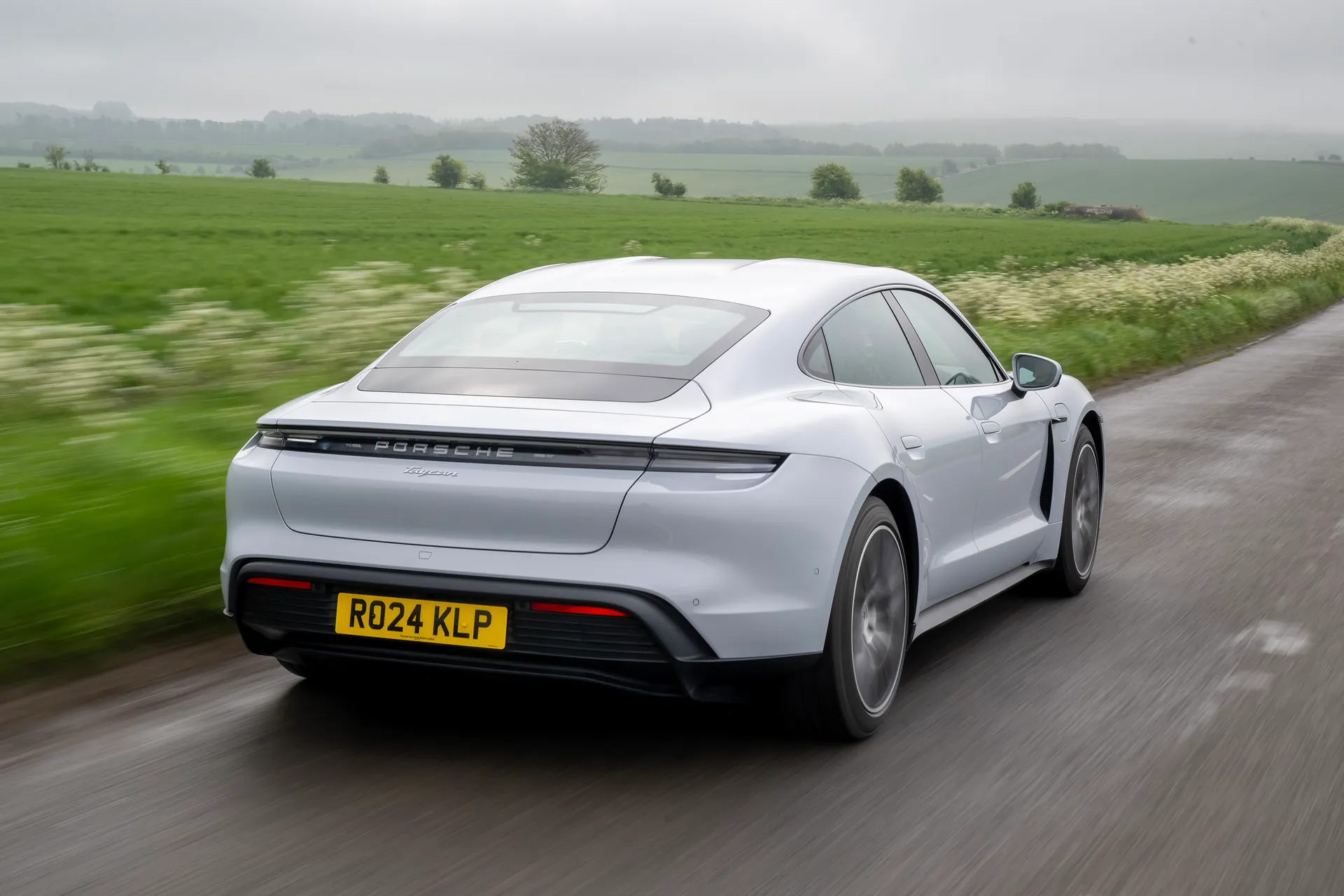
There are a few caveats to this. Firstly, conditions have to be optimal, and secondly, you need to find a charging station powerful enough to make the most of the Taycan's 320kW charging capability. To be fair, 350kW units are becoming much more common, but you'll want to avoid charging at any public rapid-charging stations, as they're very expensive. That 10-80% charge could cost you as much as £50 or more.
You could fully charge the Taycan from near-empty at home for half that price, or do the same 10-80% charge for about £18. If you're savvy, though, you'll get yourself on a variable electricity tariff and take advantage of particular times of day (typically overnight) when the per-kwh charge is slashed.
In terms of home-charging times, using a home wallbox will take around 14 hours for a full charge. It'll take several times that to do so using a three-pin plug, and it won't be great for your home's electrics, so only top up your Taycan this way if it's unavoidable.
Porsche Taycan reliability and warranty
Although Porsche tends to do well in the HonestJohn.co.uk Satisfaction Index, placing 8th of 35 brands in the 2025 edition in terms of reliability, there have been a few reliability issues reported with the Taycan, including quite a few recalls. Cars from after the 2024 facelift, should, we'd hope, prove more reliable.
Should you nee to fall back on the warranty, it lasts for three years and isn't limited by mileage. As is typical for EVs, there's a separate warranty for the battery lasting eight years or 100,000 miles, whichever comes first.
Insurance groups and costs
It won’t be cheap to insure, with all models sitting in groups 48 to 50. Then again, if you’re in the league of Taycan ownership that’s not likely to be a surprise, nor be in any way an issue.
VED car tax: What is the annual road tax on a Porsche Taycan?
Like all electric vehicles, the Porsche Taycan has been exempt from paying vehicle tax. From 1 April 2025, though, EVs will be liable for the same rate of tax as combustion-powered vehicles, the rate for which is going up slightly to £195.
You'll take an even bigger hit from years two to five of ownership thanks to the government's premium car tax, which even the base Porsche Taycan is far beyond the £40,000 threshold for. The £425 annual charge is based on the original purchase price and is transferable with the car, so buying used doesn't get you out of paying.
Porsche Taycan price
"With a few options added, even a base Taycan will cost the best part of £100,000, but you can pay less than half that by opting for a used example."
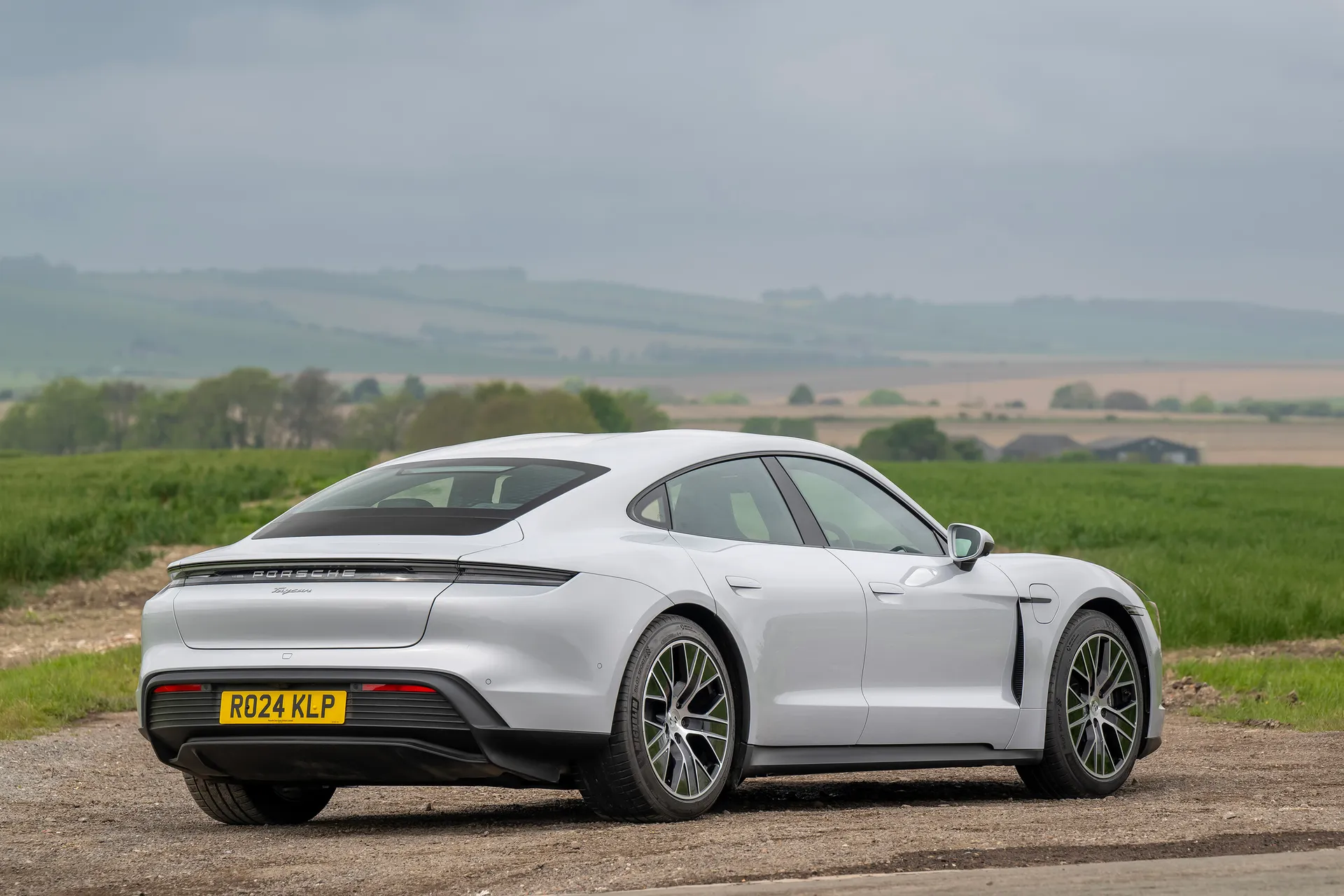
In terms of new pricing, it's £88,200 for the base Taycan, £96,200 for the Taycan 4S, £118,200 for the GTS, £135,200 for a Turbo, £162,200 for a Turbo S and a whopping £189,200 if you're after either the Turbo GT or the Turbo GT with Weissach Package.
It's not a cheap car, then, and that's before you've opened up the configurator, which presents a bewildering number of ways to inflate the price further. Some of these are, of course, fripperies, including £240 to have the Porsche logo embossed in the centre console storage lid, and a wallet-busting £17,210 for the Paint to Sample plus service, but some are features we now expect to see as standard on cars that cost considerably less.
It seems pretty mean on a car this expensive, for instance, to charge £648 for keyless entry on all but the range-topping Turbo GT. A 360-degree parking camera is an optional extra on all Taycan derivatives, too, and you'll even need to pay extra to configure the Taycan as a five-seater. At least adaptive cruise control is now standard across the range. Before the 2025 spec changes, it was a £1,092 option on all models.
Porsche's popular Sport Chrono package is £1,055 extra on models lower down the pecking order. It comes with a fancier steering wheel with heating, an analogue and digital stopwatch, a Sport Plus mode and the option to record telemetry during circuit driving. A version with a fancier stopwatch/clock is £1,838.
If you want to spend less on a Taycan and don't fancy getting bogged down with weighing up expensive options, we've good news, as there are used examples of the Taycan starting only a little over £40,000. That'll involve an early model, but you can go for a more recent post-facelift Taycan on the used market and still save a chunky five-figure sum.
Trim levels and standard equipment
The base Taycan is called ...the Taycan. It comes with 19-inch alloy wheels, eight-way electrically adjustable seats, adaptive dampers, matrix LED headlights, a reversing camera, lane-keeping assistance, a driver awareness monitor, adaptive cruise control two-zone climate control and a 10-speaker sound system.
The 4S is broadly the same in terms of equipment as the Taycan, with its main differentiating factor being an extra motor to provide more power and an all-wheel drive system. If you want a bump in equipment without ticking boxing in the configurator, you'll need to upgrade to the Taycan GTS, which is more powerful and has a sportier suspension tune, along with a healthy uplift in equipment.
Before it was rolled out as standard across the range, the GTS added the larger Performance Battery Plus. As before, this derivative also includes torque vectoring (this varies the torque output between each side of the car to improve cornering performance), 18-way electrically adjustable sport seats, a heated steering wheel, upgraded matrix LED headlights, different bumper designs, air suspension 20-inch alloy wheels, the Sport Chrono package, a Bose surround sound system and upgraded brakes.
The Taycan Turbo isn't all that different in terms of equipment other than its 14-way electrically adjustable sports seats. It mostly differentiates itself through additional performance. The Turbo S, meanwhile adds 21-inch alloy wheels, 18-way adjustable sports seats, carbon ceramic brakes and rear-axle steering.
Turbo GT adds 21-inch lightweight forged wheels, bucket seats, an aerodynamics package, carbon fibre interior trim and acoustic glass, while the Turbo GT with Weissach package features an even more lairy aero pack with a fixed carbon fibre rear wing and a rear seat delete. The latter seems like a token weight-saving gesture in a car weighing over two tonnes, if you ask us.
Ask the heycar experts: common questions
Is the Porsche Taycan the best electric car?
Is the Porsche Taycan a four or five-seater?
Is the Porsche Taycan electric?
Get our latest advice, news and offers
Keep me updated by email with the latest advice, news and offers from heycar.
By submitting you agree to our privacy policy
